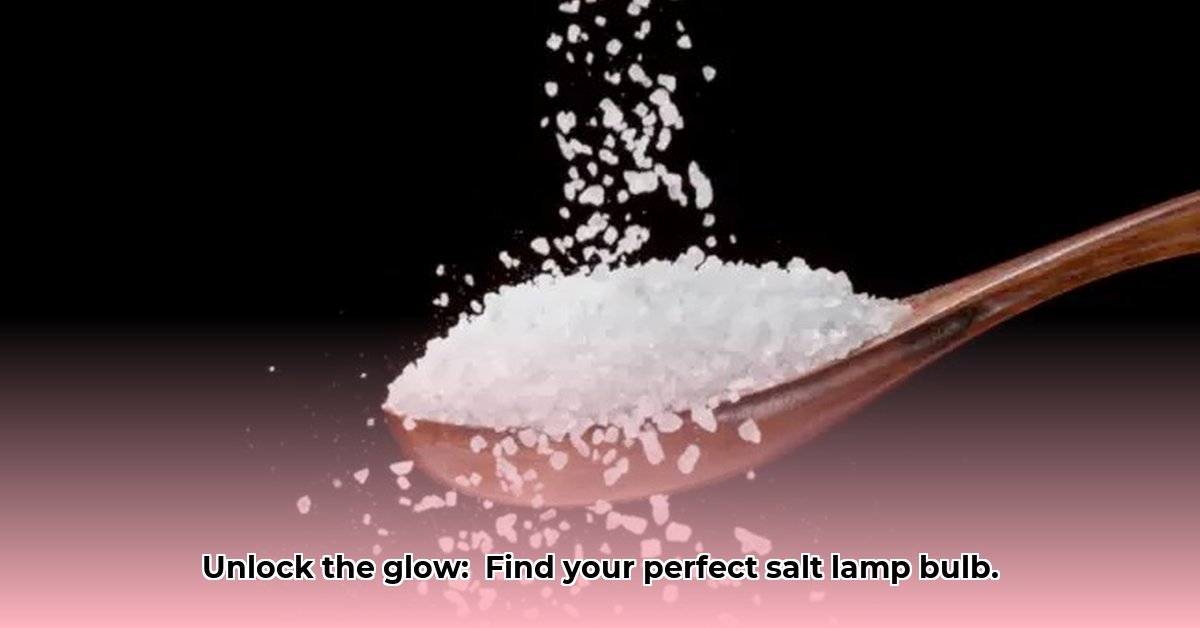Salt lamps, known for their ambient glow and purported air-purifying qualities, require the right bulb to maximize their benefits. This guide provides detailed advice on selecting the perfect bulb for your salt lamp.
Understanding Salt Lamp Bulb Wattage
Wattage dictates the heat output of the bulb, influencing the lamp’s functionality and effectiveness. Insufficient heat may diminish the lamp’s ability to attract moisture, a key part of the supposed air-purifying process. Excessive heat, on the other hand, can lead to premature bulb burnout or damage to the lamp itself. Therefore, finding the “sweet spot” depends on the lamp’s size and design.
- Small lamps (3-11 lbs): Typically require a 15-watt bulb to provide adequate warmth and light.
- Medium lamps (12-20 lbs): Often perform best with a 25-watt bulb.
- Large lamps (21-40 lbs): Usually need a 40-watt bulb to generate sufficient heat.
- Extra-large lamps (41-200 lbs): May require 50-60 watt bulbs for optimal function.
- Manufacturer Recommendations: Always consult the manufacturer’s recommendations printed on the lamp, box, or manual to ensure optimal performance and safety. These recommendations are tailored to the specific design and size of your lamp.
Choosing the correct wattage prevents damage and optimizes the lamp’s potential benefits.
Incandescent vs. LED: Choosing the Right Bulb Type
Incandescent bulbs have been the traditional choice for salt lamps because they produce heat, which is believed to be crucial for activating the salt crystals and promoting ionization. However, LED bulbs offer greater energy efficiency and longevity.
Incandescent Bulbs:
- Pros: Produce a warm, amber glow often considered relaxing. Generate heat, which some believe is essential for the lamp’s function. Generally less expensive upfront.
- Cons: Consume more energy. Have a shorter lifespan. Can get very hot, posing a burn risk.
LED Bulbs:
- Pros: Energy-efficient, saving money on electricity bills. Long lifespan, reducing the frequency of replacements. Produce less heat, minimizing the risk of damage to the lamp. Available in a wide range of colors and styles.
- Cons: May not produce as much heat as incandescent bulbs. Can be more expensive to purchase initially. Some users find the light less warm and inviting than incandescent bulbs.
Making the Choice: The decision depends on individual priorities. If maximizing heat output for therapeutic effects is paramount, incandescent bulbs remain a viable option. However, if energy savings and longevity are more important, LED bulbs are a better choice.
Maximizing Bulb Longevity: Essential Tips
Extending the lifespan of your salt lamp bulb saves money and reduces the hassle of frequent replacements.
Bulb Quality
Invest in high-quality bulbs. Cheap bulbs often have thin filaments that are prone to burning out quickly, even with slight power surges.
Inspecting the Wiring
Regularly inspect the lamp’s wiring for damage. Moisture can cause short circuits, which can lead to premature bulb failure and potential safety hazards.
Preventing Moisture Exposure
Protect the lamp from excessive moisture, as moisture can damage the bulb and other electrical components. Avoid placing the lamp in humid environments, such as bathrooms or near windows.
Using a Dimmer Switch
Consider using a dimmer switch to control the brightness of the bulb. Dimming the bulb can reduce heat output and extend its lifespan.
Avoiding Rough Handling
Handle the lamp and bulb gently to prevent damage. Avoid knocking or bumping the lamp, as this can weaken the filament and shorten its lifespan.
The Aesthetics of Light: Choosing the Right Color Temperature
Beyond function, the light emitted by your salt lamp significantly impacts a room’s ambiance. A warm white or amber glow creates a cozy and relaxing atmosphere, while a cooler light can feel more energizing.
Color temperature, measured in Kelvin (K), plays a crucial role in determining the color of the light.
- Warm White (2700K-3000K): Produces a warm, yellowish light that is ideal for creating a relaxing and inviting atmosphere.
- Cool White (3500K-4100K): Emits a brighter, more neutral light that is suitable for tasks requiring more illumination.
- Daylight (5000K-6500K): Produces a crisp, blueish light that mimics natural daylight and is often used in offices and workshops.
Choose a color temperature that complements your room’s décor and the mood you wish to create. For salt lamps, warm white or amber bulbs are generally preferred to enhance the relaxing ambiance.
A Step-by-Step Guide to Choosing the Perfect Salt Lamp Bulb
Finding the perfect bulb can be a simple process:
- Measure Your Lamp: Measure the height and diameter of the bulb cavity to estimate the appropriate bulb size and wattage.
- Check the Socket: Identify the bulb’s base type. Common types include the candelabra base (E12), intermediate base (E17), and standard base (E26).
- Select the Wattage: Based on your lamp’s size and manufacturer’s recommendations, select a wattage that provides adequate heat and brightness without overheating the lamp.
- Choose a Bulb Type: Decide between incandescent (more heat, less energy-efficient) or LED (less heat, more energy-efficient) based on your priorities.
- Consider Color Temperature: Choose a color temperature that complements your room’s décor and creates the desired mood. For a warm and relaxing glow, opt for a lower Kelvin value (2700K-3000K).
- Purchase and Installation: Buy your chosen bulb, carefully install it, and test your lamp to ensure it is functioning properly.
Incandescent vs. LED: A Detailed Comparison
This table summarizes the key differences between incandescent and LED bulbs for salt lamps:
| Feature | Incandescent | LED |
|---|---|---|
| Heat Output | High; considered essential for salt lamp benefits by some | Low; may reduce potential therapeutic effects for those who believe in the ionization properties |
| Energy Efficiency | Low; uses more electricity | High; saves electricity, reducing energy bills |
| Lifespan | Moderate, typically lasting 1,000-2,000 hours | Long; can last for 25,000-50,000 hours |
| Light Color | Typically warmer, amber glow | Color varies; available in a wide range of color temperatures |
| Initial Cost | Generally less expensive to buy | Usually more expensive upfront, but cost is offset by energy savings and longer lifespan |
| Durability | More fragile; prone to breakage | More durable; less susceptible to damage |
| Environmental Impact | Higher; consumes more energy and may contain hazardous materials | Lower; consumes less energy and is generally more environmentally friendly |
By carefully considering these factors, you can find a bulb that enhances your lamp’s appearance, maximizes its potential benefits (real or perceived), and fits your budget.
How to Choose the Best LED Bulb for a Himalayan Salt Lamp
Finding the perfect LED bulb for your Himalayan salt lamp means balancing energy efficiency with the desired warm glow that many associate with these lamps.
Measuring Your Existing Bulb
Accurately measuring your current bulb is crucial for finding a suitable replacement. Note the base type (e.g., E12, E14, E17) and bulb diameter to ensure a proper fit.
Understanding Wattage
Wattage determines the bulb’s brightness and heat output. LEDs produce less heat than incandescent bulbs for the same brightness, so you can often use a lower wattage LED bulb to achieve the same level of illumination.
Choosing the Right LED Bulb: Key Factors
- Wattage: Match the wattage of your original bulb, but consider using a lower wattage LED bulb (e.g., a 2-watt LED to replace a 15-watt incandescent).
- Color Temperature: Opt for a lower Kelvin value (2700K-3000K) to replicate the warm, amber glow of an incandescent bulb.
- Base Type: Ensure the base type matches your lamp’s socket for a secure and reliable connection.
- Dimmability: If you want to control the brightness of your lamp, choose a dimmable LED bulb and a compatible dimmer switch.
LED Bulb Lifespan
LED bulbs offer significantly longer lifespans than incandescent or CFL bulbs, reducing the frequency of replacements and saving you money in the long run.
Common Bulb Types and Characteristics
| Bulb Type | Wattage Range | Lifespan (Hours) | Heat Output | Color Temperature (K) |
|---|---|---|---|---|
| Incandescent | 15-60W | 1000-2000 | High | 2700-3000 |
| Compact Fluorescent | 7-15W | 8 |
- Glass Tile Shower Ideas to Create a Stunning Bathroom Space - December 7, 2025
- Glass Wall Tile Ideas for Kitchens and Bathrooms - December 6, 2025
- Glass Tile Bathroom: Create a Beautiful, Easy-Clean Space - December 5, 2025










